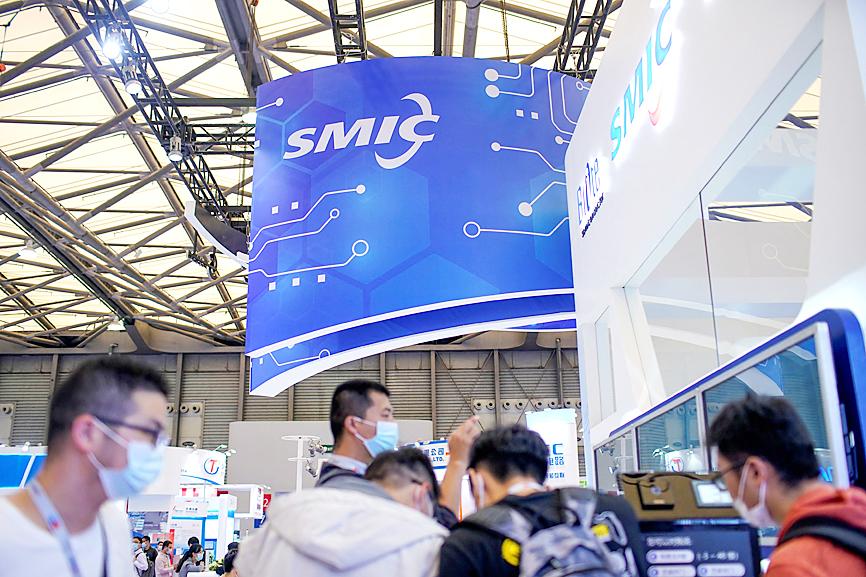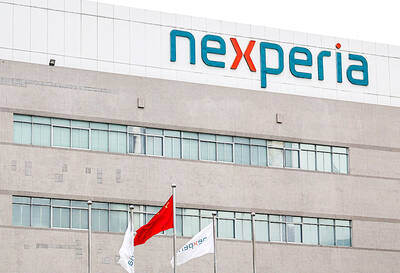Semiconductor Manufacturing International Corp (SMIC, 中芯) has likely advanced its production technology by two generations, defying US sanctions intended to halt the rise of China’s largest chipmaker.
The Shanghai-based manufacturer is shipping bitcoin-mining semiconductors built using 7 nanometer technology, industry watcher TechInsights wrote in a blog post on Tuesday.
That would be well ahead of SMIC’s established 14 nanometer technology, a measure of fabrication complexity in which narrower transistor widths help produce faster and more efficient chips.

Photo: Reuters
Since late 2020, the US has barred the unlicensed sale to the Chinese firm of equipment that can be used to fabricate semiconductors of 10 nanometers and beyond, infuriating Beijing.
A person familiar with the developments confirmed the report, asking not to be named as they were not authorized to discuss it publicly.
SMIC’s surprising progress raises questions about how effective export controls have been, and whether Washington can thwart China’s ambition to foster a world-class chip industry at home and reduce reliance on foreign technologies. It also comes as US lawmakers have urged Washington to close loopholes in its Chinese-oriented curbs and ensure Beijing is not supplying crucial technology to Russia.
The restrictions effectively derailed Huawei Technologies Co’s (華為) smartphone business by cutting it off from the tools to compete at the cutting edge.
Previously, SMIC has said that its core capabilities stand at 14 nanometers, two generations behind 7 nanometers, which is about four years behind the most advanced technology available from Taiwan Semiconductor Manufacturing Co (台積電) and Samsung Electronics Co.
SMIC has worked with clients on technologies more advanced than 14 nanometers as early as in 2020, it said on an earnings call that year.
China-based MinerVa Semiconductor Corp, which is named as SMIC’s customer in the TechInsights report, showcases a 7 nanometer chip on its Web site and said mass production began in July last year, without specifying the manufacturer.
SemiAnalysis lead analyst Dylan Patel was first to note the report.
Representatives of SMIC and MinerVa did not immediately respond to requests for comment.
The labels attached to generations of chip production technology have become increasingly controversial as they no longer represent dimensions of the microscopic transistors that give chips their electronic function. Companies have accused each other of mislabeling their products to make them appear more advanced than they actually are.
While the ability to produce a small number of chips using the next level of production technique signals that a company is making technological progress, what determines economic viability — under normal circumstances — is yield, or the percentage of every production run that is successful.
Intel Corp, once the leader in production technology, stalled on one type of production for five years because it could not get enough viable chips to make it profitable to introduce that node into mainstream production.
However, SMIC is not operating under standard business conditions.
It is critical to China’s ability to produce chips domestically, as the US tries to undercut the country’s tech advancements. Beijing might be willing to subsidize losses at domestic competitors, including SMIC, out of fear that its companies would not have access to key components.

JITTERS: Nexperia has a 20 percent market share for chips powering simpler features such as window controls, and changing supply chains could take years European carmakers are looking into ways to scratch components made with parts from China, spooked by deepening geopolitical spats playing out through chipmaker Nexperia BV and Beijing’s export controls on rare earths. To protect operations from trade ructions, several automakers are pushing major suppliers to find permanent alternatives to Chinese semiconductors, people familiar with the matter said. The industry is considering broader changes to its supply chain to adapt to shifting geopolitics, Europe’s main suppliers lobby CLEPA head Matthias Zink said. “We had some indications already — questions like: ‘How can you supply me without this dependency on China?’” Zink, who also

At least US$50 million for the freedom of an Emirati sheikh: That is the king’s ransom paid two weeks ago to militants linked to al-Qaeda who are pushing to topple the Malian government and impose Islamic law. Alongside a crippling fuel blockade, the Group for the Support of Islam and Muslims (JNIM) has made kidnapping wealthy foreigners for a ransom a pillar of its strategy of “economic jihad.” Its goal: Oust the junta, which has struggled to contain Mali’s decade-long insurgency since taking power following back-to-back coups in 2020 and 2021, by scaring away investors and paralyzing the west African country’s economy.

Taiwan Semiconductor Manufacturing Co (TSMC, 台積電) received about NT$147 billion (US$4.71 billion) in subsidies from the US, Japanese, German and Chinese governments over the past two years for its global expansion. Financial data compiled by the world’s largest contract chipmaker showed the company secured NT$4.77 billion in subsidies from the governments in the third quarter, bringing the total for the first three quarters of the year to about NT$71.9 billion. Along with the NT$75.16 billion in financial aid TSMC received last year, the chipmaker obtained NT$147 billion in subsidies in almost two years, the data showed. The subsidies received by its subsidiaries —

BUST FEARS: While a KMT legislator asked if an AI bubble could affect Taiwan, the DGBAS minister said the sector appears on track to continue growing The local property market has cooled down moderately following a series of credit control measures designed to contain speculation, the central bank said yesterday, while remaining tight-lipped about potential rule relaxations. Lawmakers in a meeting of the legislature’s Finance Committee voiced concerns to central bank officials that the credit control measures have adversely affected the government’s tax income and small and medium-sized property developers, with limited positive effects. Housing prices have been climbing since 2016, even when the central bank imposed its first set of control measures in 2020, Chinese Nationalist Party (KMT) Legislator Lo Ting-wei (羅廷瑋) said. “Since the second half of